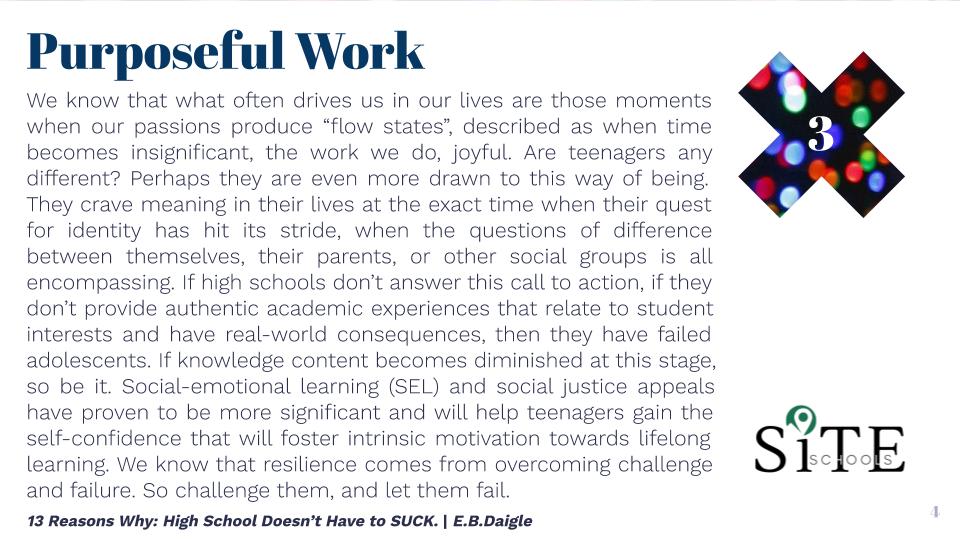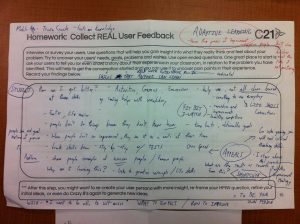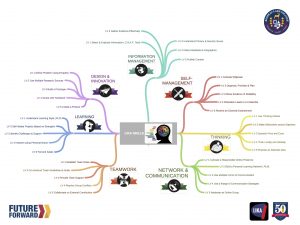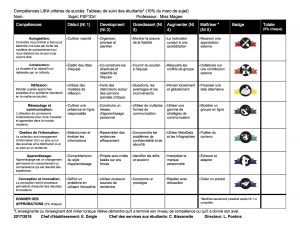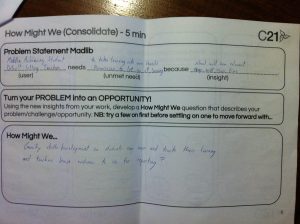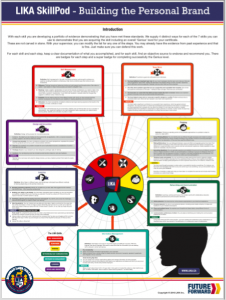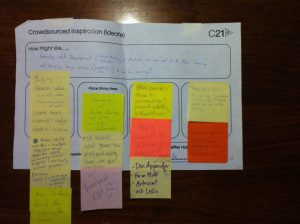Tag Archives: soft skills
Gamifying 21st Century Skills: Part 2
FULL DISCLOSURE: (this post was first written, like, months ago, and then not published, and then completely abandoned, and now, in desperation to publish something, published; still not sure on the why, nevertheless working on the how!)
When you blow-up any traditional concept, in education or otherwise, there is always the inherent danger the pieces of your good intentions may become scattered and disconnected from the whole. Another way of saying this is, if you are not careful, you may lose your audience. Or in this case, your student? Or, as Australians are prone to say— the proverbial plot!
In my over ten years of teaching, I have found that educators typically fall into two somewhat contradictory mindsets: those who feel strongly we are preparing students for the harsh realities of the world, and those who believe students are the ones who will create their own brave new world. Did you notice the subtle yet fundamental difference there? One proposes to enrich a generation with the passed-down tools of success, the other prefers to engender resilience through autonomy. I am willing to admit that over the years I have found myself on both sides of this debate. I don’t believe either stance is necessarily the correct one. In fact, I am almost certain you need both of them in order to improve student engagement and achievement, in order to make education relevant again.
In my last post, I began the process of describing the intentions and HMW questions behind my Action Research Plan. To quote George Lucas, creator of Star Wars, who we are perhaps only now recognising will go down in history as the Charles Dickens of the 20th century or at the very least the John D. Rockefeller, “ideas are cheap”. What he meant by this, in spite of his billion-dollar Disney payout, is that anyone can have a good idea, but only the intrepid few can make it past the initial wonder-wall of sticky-note brainstorming and into the deadline-centric prototyping arena.
I am not usually one of those intrepid few. But I know a few people who are, and that has made all the difference.
THOSE NEXT STEPS
There have been plenty. Too many. I should have a pedagogical Fitbit for this.
Let us speed-date our way through this Escher. First, there was the User Feedback. I interviewed a student and a teacher, both of whom would benefit from this initiative. Here are some student thoughts around the why and how of skill development:
At one point I even had a few students on board to create a critical thinking APP. That idea quickly died when we all realised no one knew the first thing about designing an APP. But boy, let me tell you the excitement in the room….
So from those very positive user comments (suggesting I was indeed heading in the right direction) I created a mindmap version of the 7 LIKA Skills which our school has already subscribed to (Self-Management, Thinking, Network & Communication, Teamwork, Learning, Design & Innovation, Information Management). You will notice that a Levelling-Up strategy was initiated with each skill unfolding into a series of 5 increasingly challenging competencies. Not quite the Nintendo-style edtech “game” I had imagined, but nevertheless, something to aspire to. And quite pretty I might add (thank you coggle.it!)
Earlier in the year, I adjusted the achievement chart at our school for all subsequent assessments to cater for a Level 5 (instead of 4+, because, hey, it’s Level 5!). I then added Quality Descriptors so that our progress reports became gradeless and work habits could now be labelled as either Beginning, Developing, Deepening, Enhancing, or Mastering.
It made sense, to me at least, for our 21st Century Skills to follow a similar success criteria.
But it wasn’t enough. How would the unpacking of this work in the classroom? Or if not the classroom, where and when would teachers guide students through these 7 skills with 5 Levels each (that’s 35 separate competencies if you’re counting). Most importantly, how would they be assessed?
Then an idea hit me after the last Cohort21 meeting on Mars. The Parlay start-up boys that spoke to our whole group had an interesting functionality on their collaborative online forum— that of endorsement!
I would get the students to track their own skill development and ENDORSE others in the class who had likewise achieved a Level-Up. So that graphic looked like this:
I still needed the teacher to be somewhat accountable for this (without it being onerous) so a class tracking sheet for the teacher was also created. It looked like this:
I then spent too much time thinking about whether or not students would even be motivated to Level-Up on their own. I toyed with the idea that we should perhaps be giving some marks for soft skills, after all, there is a very good argument that all of these can be cultivated through each subject area and often make up a significant component any curriculum document (read your first 15 pages if you don’t believe me). But Should that be 5% of their final mark, 10%?
What if each student in the class started with a baseline 50% and then was given 5% for each skill they obtained and/or each endorsement? They wouldn’t be required to complete all 35 LIKA Skills, just 5 skills and 5 endorsements in order to reach 100%.
It wasn’t until a particularly poignant Google Hangout call with some Cohort21 alumni members that convinced me the road to success is not paved with extrinsic motivation. I couldn’t slide back into marks after having called for their exile! There would have to be another way!
While I was waiting for this other way, I asked our French teacher to get the kids to help them translate our new skills chart into French. It was a cool distraction, and resulted in this:
And so… HERE IS WHERE I AM! This is where my bitumen-paved butt hits gravel…. for a limited time only.
As the teaching faculty at my school and I prepare ourselves for another whole-school initiative (DISCOVERY DAYS, don’t ask, but please, ask?), I decided it was too much, too soon to unleash this particular 21st Century Skills beast on them. I wouldn’t say I’ve shelved it insomuch as I’ve merely back-burnered it for later in the year.
A few ideas that have recently hit me regarding the use and assessment of these skills:
- perhaps they are used as a way to strengthen abilities for student passion projects instead of assessed by each teacher in their subject areas
- explicitly taught and tracked by mentors
- LV 5 badges attached to high school transcript
REFLECTION
There is another difference I’ve noticed over the years, regarding how teachers conduct themselves in the workplace. There are those teachers who would like to be told exactly what to do, and there are those who work best when left alone to do their own thing. Again, at various points in my career, I’ve found myself on both sides of this professional fence— very often dependent on the workload, one doesn’t always have time to play in the clouds when all you can do most days is survive unscathed.
We are lucky to be engaged in a profession where we are, to a certain degree, responsible only to ourselves, our own individual classrooms, our own knowledge and expertise, our students. I cherish this about teaching. I have also, only just this year, understood the vital importance of networking and collaboration in my reflective practice. Cohort21 is the first time in my professional life I’ve felt this way.
A huge thanks to @ddoucet, @shelleythomas, @jsmith, @brenthurley, @jweening, @egelleny, @timrollwagen, @Think_teach, @jmedved, @lesmcbeth and others I may have failed to mention, for their continued assistance, guidance, ENDORSEMENT, and encouragement.
Finally, a non-baby-boomer PD! Cohort, you make me feel 21 again!
Gamifying 21st Century Skills: Part 1
Cohort21 continues to be a game-changer for me.
Mentally shifting my previous professional teaching experiences, from schools of well-intentioned colleagues, to this collaborative learning hive of like-minded ed-heads, has transformed my teaching practice in ways I have yet to truly reflect on. Except here:
I walked into the last F2F meeting with more than just a head-cold; I also had a head full of ideas and scatterbrain proposals from which to dump on this unsuspecting source of formative feedback junkies. My new role as Academic Lead at Rosseau Lake College has awarded me the freedom to develop areas of interest that “might” just indeed help our school move forward. Of course, almost instantaneously, the dreaded symbolic starting block reared it’s cosmetically challenged head, in oversized, day-glo sky-writing: Where do I begin?
LEVEL 1: THE WHERE
Luckily, our esteemed facilitators (@jmedved & @gnichols) and coaches at Cohort21, are well-versed in the language of stumble, and had problem-solving solutions waiting in the wings (literally, the wings of the York School hallways, used brilliantly as limbic nerve-system galleries of crowd-sourcing). The Design Thinking worksheets, sticky-note brainstorms and timed exercises, provided by @lmcbeth and Future Design School, were also a wonderfully scaffolded entry point into generative thinking, well away from the usual Saturday PD day-dreaming and doodle sessions of my past.
My original intention was to use the Cohort community as supercharged leverage for reimagining and rebooting our Master Schedule— a commitment to change which RLC (Roseau Lake College) is currently highly invested in. The unique process of design-thinking around this challenge, we began as a school last spring; with typical brainstorming results benefiting most from a speculative standpoint, with the not unusual— sometimes confusing and muddling— side effect of losing some staff through endless permutations of opportunity and critique. Ultimately, I concluded, that, as a school, we were already well ahead in unpacking this sticky-note problem— already at the prototyping phase, really (exciting stuff, TBA!)— and this being too specific a challenge, to be used as my Cohort21 action research springboard.
So, as a poet of pedagogy, as an agent of change, an adjunct adaptor of assessment, and as I am wont to do, I revised my original plan. Not changed tactics so much as I lessened the scope of my (ego)concentric circle to focus on another of my whole-school pet passion projects/peeves: 21st Century Skill Development.
1. Essential Skills from Most Likely to Succeed on Vimeo.
LEVEL 2: THE WHY
I’m certainly not the first teacher to notice the writing on the pedagogical wall; the recent paradigm shift in teaching and learning, away from content and towards competencies, has been slowly evolving over the past decade or more (http://www.p21.org/our-work/resources/for-educators#SkillsMaps). The internet is a far better provider of knowledge than any one teacher could ever hope to be. One only need look at the proliferate example of Khan Academy, how its open-source adaptive technology has enabled a whole new generation of students to effectively tech-learn numeric knowledge in a scaffolded way, previously only possible through linear textbook instruction (Khan has naturally set their sites on literacy and grammar as well: https://www.khanacademy.org/humanities/grammar)
This evolution is a great relief to me, I’ve never been interested in any aspect of teaching that has me churning out cookie-cutter lessons or exacting standardized assessments like a machine; unfortunately, this delicate transition has been an obstacle to some teachers who have, perhaps unconsciously, staked, not only their professional claim, but also their identity around a proven silo of knowledge and/or singular interpretation of curriculum (especially at the secondary school level). I say, let the robots take over all the deductive aspects of school and learning! The computer has already made obsolescence a fact of life in other disciplines such as banking, manufacturing, health, military— why not education? If we, as educators, want to not only stay relevant, but also stay employed in the 21st century, we need to use content to teach skills. We need to become critical and creative facilitators of deeper learning skills and life skills. We need to become Poets of Pedagogy!
LEVEL 3: THE WHAT
After much reflecting and validating (… the Discovery Process…) on a possible teaching problem, and through the integral help of a feedback partner (@vboomgaardt), I finally widdled-down my “mighty” action research question:
How might we gamify 21st century skill development, so students can track their own learning, and teachers can gain meaningful evidence for feedback and reporting?
In order to arrive at this question, I first had to empathize with TWO END USERS in my design problem: both students and teachers. TWO END USERS!?! I think that’s okay, isn’t it? Yes, I think that’s just fine. The students will, of course, be the benefactors of a more streamlined, transparent, credential-focussed, success-driven criteria program around 21st century skill development. The teachers, as well, will need to be able to adapt these competencies and rubrics into their curriculum in ways that deepen and heighten curriculum expectations. If, along the way, we can get all edtech and add an app somewhere in the mix, well, hell, as my grandmother used to say, we’re cookin’ with gas!
Throughout this iterative process, I asked around the cohort to see if other CIS schools had identified “soft skills” as a potential problem worth solving. Similar questions around competencies did indeed exist, however, the conclusion I came to was although every school reported on work habits and had even made inroads into critical and creative thinking, there didn’t seem to be a whole-school system out there for assessing competencies in an intrinsic or adaptive way. It seems to very much still be at the mercy of individual teachers, which doesn’t really signal to the students or parents the importance of this shift in education. One of the simple questions I asked my fellow teachers was this: “What is the difference between a Grade 7 collaboration and a Grade 12 collaboration when it comes to assessing work habits?”. No one was able to give me an answer with any authority or consistency. With this Action Plan, I am to change that.
LEVEL 4: THE HOW
“Curious kids learn how to learn, and how to enjoy it – and that, more than any specific body of knowledge, is what they will need to have in the future. The world is changing so rapidly that by the time a student graduates from university, everything he or she learned may already be headed toward obsolescence. The main thing that students need to know is not what to think but how to think in order to face new challenges and solve new problems.” (p.14)
This is from Amanda Lang’s, The Power of Why. I haven’t read her book, and I probably won’t have time, sadly. Nevertheless, this quote, taken from a MindShift blog about skills education (https://ww2.kqed.org/mindshift/2013/11/14/why-academic-teaching-doesnt-help-kids-excel-in-life/), resonated with my predicament.
When I arrived at Rosseau Lake College last year, they had already started a transition into a new strategic plan (Future Forward) which I am lucky to help continue to shape this year. One of the hallmarks of this plan is a personalized approach to education, using what we call a PLP (Personalized Learning Profile). Partnering with the learning and development company, LIKA (http://www.lika.ca/home2/), our students are able to approximate their learning preference through a multiple-intelligence, psychometric online test. Simply, this allows each student and teacher to see individual learning strengths and weaknesses as a visual quadrant infographic.
In addition to the PLP, LIKA has recently developed a list of 7 Skills which have already been Ministry approved and will form the foundation of RLC’s 21st Century Competencies.
These skills will be the basis for my Action Plan:
- Self-Management
- Teamwork
- Thinking
- Networking and Communication
- Information Management
- Learning
- Design and Innovation
Finally, through the crowd-sourcing inspiration stage of our last F2F, I received a heap of ideas, many of them game and tech-related, to help me on my quest.
LEVEL 5: THE WHEN
It’s all happening in Semester 2. I am lucky to have both Junior and Senior Division Curriculum leads to help co-construct criteria around these skills. There is much research to conduct around badge creation, interactive motivator apps, Google Suite apps, JoeZoo, Doc Appender, and LMS systems. As well, I will be interviewing both of my END USERS throughout the process for feedback and suggestions.
A huge thanks to @ddoucet, @shelleythomas, @jsmith, @brenthurley, @jweening, @egelleny, @timrollwagen, and others I may have failed to mention, for their continued assistance, guidance, and encouragement.
To be continued in PART 2.

